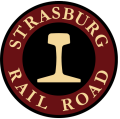 Strasburg Rail Road History
Strasburg Rail Road History
Strasburg, Pennsylvania—a Rockwell-esque small town in the middle of bucolic Pennsylvania Dutch Country—is home to the oldest continuously operating railroad in North America and the most visited heritage railroad in the continental United States. Chartered in June 1832, the Strasburg Rail Road began serving the community of Strasburg with both in antebellum America when covered wagons and canals were still commonplace.
For the next 107 years, business at the Strasburg Rail Road ebbed and flowed until 1958 when a group of local investors purchased “the Methuselah of railroads” to not only keep it alive but to develop it for bigger and better operations.
Today, 200 years later, the railroad has an active freight department and world-renowned restoration shops while still dedicated to its mission to provide an early 20th-century steam railroading experience in a safe, clean, and friendly environment.
THE BEGINNING
When the Philadelphia & Columbia Railroad (P&C) began construction of its 82-mile rail line from Philadelphia to Columbia, Pennsylvania, in 1831, it circumvented the town of Strasburg by nearly five miles. It meant a near deathblow to the commercial and agricultural interests in Strasburg that heretofore helped rank Strasburg as the most populous and richest town in Lancaster County surpassing even the county seat, Lancaster.
In response to the political kerfuffle that followed, the Commonwealth of Pennsylvania granted a charter in the summer of 1832 to create the Strasburg Rail Road so that the businesses and citizens in Strasburg would have a direct rail connection to the P&C’s mainline, thus saving their influence and profitability in the larger Lancaster community.
History records little of what happened with the Strasburg Rail Road in the 20 years after its charter. What is known, however, is that by 1835 enough shares had been sold to fund the grading and construction of the roadbed. The financial Panic of 1837 severely hindered the further development of the railroad and postponed the town’s advancement via a direct rail connection to the mainline.
By the late 1840s, the economy had stabilized enough to spur local interest in reviving the railroad. By 1851 the Strasburg Rail Road became incorporated and soon after began carrying passengers and freight to and from the now-Pennsylvania Railroad junction in Paradise, Pennsylvania, thus fulfilling the dream that started twenty years before.

A SECOND CHANCE
By 1954, the Strasburg Rail Road had weathered four wars, three depressions, and one government takeover. Through it all, the railroad continued to operate on its 4½-mile run to the mainline, despite the rapidly declining condition of its weed-infested rails. Through much of the early 1950s, railroad operations were sporadic at best. With hauling roughly 200 carloads of freight annually and with annual gross revenue of less than $3,000, the Strasburg Rail Road was the smallest and possibly the poorest railroad in the nation. The lack of frequent business, inadequate funds, and insufficient manpower were three reasons why the physical condition of the railroad was so dilapidated.
In late March 1958, a week after a blizzard dumped more than a foot of snow, Henry K. Long, Donald E. L. Hallock, and several fellow railroad enthusiasts met to discuss the purchase of the Strasburg Rail Road from the Homsher estate. They were determined to keep what was described as “the Methuselah of railroads” alive. They were determined to save Strasburg.
After the better part of a year of dedicating their time and effort in clearing waist-high weeds, repairing rails, and relaying ties, their dream became a reality on November 1, 1958, when the sale of the railroad was completed. A new day was dawning on the Strasburg Rail Road.
When the well-connected, yet modest, group of local rail fans purchased and subsequently revived passenger service at the Strasburg Rail Road, little did they know how popular their railroad would soon become. During the first year of tourist passenger operations in 1959, annual ridership was slightly less than 9,000—still impressive for a relatively obscure railroad in Amish Country. However, by 1962—just three years after reviving railroad passenger operations—when ridership surpassed 125,000, the group of 24 individuals knew they were onto something.
By 1960, excursion trips were so popular that passenger operations needed more substantial motive power. The directors looked for a solution. Their solution was steam.

TODAY
The Strasburg Rail Road offered something unique to the visitor. It offers fully restored steam locomotives in a world where steam motive power had been replaced with diesel/electric. It offers beautifully restored wooden railcars in a world where the wooden railcar was obsolete for commercial purposes. And it offers a 45-minute, fully narrated ride through picturesque Amish Country farmland during a time when tourists could not get enough of anything “Amish.”
From its first steam locomotive purchase in 1960 to today, Strasburg’s reputation for steam restoration, repair, and refurbishment is unequaled. The shops, staff, and roster of serviceable steam locomotives are unparalleled.
Coupled with that is the car shop where 100-year-old wooden coaches are fully restored to their original beauty. Strasburg Rail Road continues to be one of the few tourist railroads dedicated to running late 19th- and early 20th-century wooden coaches for its passenger service.
Over a half-century later, the Strasburg Rail Road remains dedicated to steam; it still ranks as one of the region’s most frequented attractions and is the most visited tourist railroad in the continental United States with annual ridership averaging 300,000 passengers.

For additional reading, see Images of Rail: Strasburg Rail Road by Arcadia Publishing, 2017.
